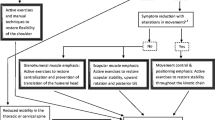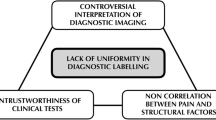Abstract
Shoulder pain is a frequent cause of musculoskeletal consultation in primary care, whose etiology of non-neurological origin may include the Rotator Cuff Disorders, Subacromial impingement, Glenohumeral Instability, Long head of the biceps lesion, and SLAP. The physiotherapeutic management of this pathology, as well as its effectiveness, starts from a well-structured differential diagnosis, which is based on the clinical reasoning process. To determine the cause of shoulder pain, the literature shows innumerable tests that can be applied during the evaluation. The aim of this manuscript is to assist the therapist in defining the specific type of musculoskeletal shoulder injury from pain of non-neurological origin. A clinical reasoning algorithm is proposed to facilitate the differential diagnosis of painful shoulder pathology in physical therapy based on clinical, visual, manual, functional, and instrumental diagnosis. This tool will allow the identification of the phases of clinical reasoning in the physical therapist, to elaborate the differential diagnosis of painful shoulder pathology, providing a novel tool in their training.
Access this chapter
Tax calculation will be finalised at checkout
Purchases are for personal use only
Similar content being viewed by others
References
Speed, C.: Musculoskeletal disorders Shoulder pain Search date February 2006 Musculoskeletal disorders Shoulder pain. Clin. Evid. http://www.ncbi.nlm.nih.gov/pmc/articles/PMC2907630/ 2006. Accessed February 2008; 2006, pp. 1–24.
Khosravi, F., Amiri, Z., Masouleh, N.A., Kashfi, P., Panjizadeh, F., Hajilo, Z., et al.: Shoulder pain prevalence and risk factors in middle-aged women: A cross-sectional study. J Bodyw Mov Ther. 23(4), 752–757 (2019)
Larsson, R., Bernhardsson, S., Nordeman, L.: Effects of eccentric exercise in patients with subacromial impingement syndrome: A systematic review and meta-analysis. BMC Musculoskelet. Disord. 20(1), 1–22 (2019)
Dhir, J., Willis, M., Watson, L., Somerville, L., Sadi, J.: Evidence-based review of clinical diagnostic tests and predictive clinical tests that evaluate response to conservative rehabilitation for posterior glenohumeral instability: A systematic review. Sports Health. 10(2), 141–145 (2018)
Martínez Lazcano, F., Avilés Cura, M., Ramírez Aranda, J.M., Riquelme Heras, H., Garza Elizondo, T., Barrón Garza, F.: Impacto de una intervención psicosocial en la carga del cuidador de niños con parálisis cerebral. Aten. Primaria 46(8), 401–407 (2014). https://doi.org/10.1016/j.aprim.2013.12.005
Lee, S.., Saifuddin, A..: Shoulder pain. Skeletal Radiol. 47(10), 1423–1424 (2018)
Kibler, W.B., Sciascia, A.: Current concepts: Scapular dyskinesis. Br. J. Sports Med. 44(5), 300–305 (2010)
Ford, B., Cohen, M., Halaki, M., Diong, J., Ginn, K.A.: Experimental shoulder pain models do not validly replicate the clinical experience of shoulder pain. Scand J. Pain (2019)
Park, J.Y.: Sports injuries to the shoulder and elbow. Sport Inj. Shoulder Elb. 1–488 (2015)
Varveris, N.K.: Differential diagnosis and physical therapy management of lumbar instability in a patient with pregnancy-related low back pain. J. Womenʼs Heal Phys. Ther. 43(2), 98–108 (2019)
Ristori, D., Miele, S., Rossettini, G., Monaldi, E., Arceri, D., Testa, M.: Towards an integrated clinical framework for patient with shoulder pain. Arch. Physiother. 8(1) (2018)
Dakkak, A., Krill, M.K., Krill, M.L., Nwachukwu, B., McCormick, F.: Evidence-based physical examination for the diagnosis of subscapularis tears: A systematic review. Sports Health 13(1), 78–84 (2021)
Monga, P., Funk, L.: Diagnostic Clusters in Shoulder Conditions. Springer, Cham, Switzerland (2017)
Carreño, F.A., Mesa, J.L., Rueda, O.: Diagnóstico de la rotura del manguito de los rotadores (pruebas clínicas e imagenología). Revisión de conceptos actuales. Revista Colombiana de Ortopedia y Traumatología 30, 13–25 (2016)
Guosheng, Y., Chongxi, R., Guoqing, C., Junling, X., Hailong, J.: The diagnostic value of a modified Neer test in identifying subacromial impingement syndrome. Eur. J. Orthop. Surg. Traumatol. 27(8), 1063–1067 (2017)
Clark, R.C., Chandler, C.C., Fuqua, A.C., Glymph, K.N., Lambert, G.C., Rigney, K.J.: Use of clinical test clusters versus advanced imaging studies in the management of patients with a suspected slap tear. Int. J. Sports Phys. Ther. 14(3), 345–352 (2019)
Jaramillo Fernández, J.C., Restrepo Rodríguez, C.: Inestabilidad de hombro: una revisión de las opciones de manejo. Rev Colomb Ortop y Traumatol 30(2), 55–60 (2016). https://doi.org/10.1016/j.rccot.2016.07.007
Lizzio, V.A., Meta, F., Fidai, M., Makhni, E.C.: Clinical evaluation and physical exam findings in patients with anterior shoulder instability. Curr. Rev. Musculoskelet. Med. 10(4), 434–441 (2017)
Hegedus, E.J., et al.: Which physical examination tests provide clinicians with the most value when examining the shoulder? Update of a systematic review with meta-analysis of individual tests. Br. J. Sports Med. 46(14), 964–978 (2012)
Chester, R., Shepstone, L., Daniell, H., Sweeting, D., Lewis, J., Jerosch-Herold, C.: Predicting response to physiotherapy treatment for musculoskeletal shoulder pain: A systematic review. BMC Musculoskelet. Disord. 14 (2013)
Jiandani, M.P., Mhatre, B.S.: Physical therapy diagnosis: How is it different? J. Postgrad. Med. 64(2), 69–72 (2018)
Gruppen, L.D.: Clinical reasoning: Defining it, teaching it, assessing it, studying it. West J. Emerg. Med. 18(1), 4–7 (2017)
Jiménez, J.: Methodological guide for preparing the physiotherapy diagnosis according to the International Classification of Functioning (CIF), disability and health. Gac. Médica. Boliv. 39(1), 46–52 (2016)
Hoo, J.S.: Shoulder pain and the weight-bearing shoulder in the wheelchair athlete 27(2), 42–47 (2019)
Ahlsen, B., Mengshoel, A.M., Bondevik, H., Engebretsen, E.: Physiotherapists as detectives: Investigating clues and plots in the clinical encounter. Med. Humanit. 44(1), 40–45 (2018)
Elvén, M., Hochwälder, J., Dean, E., Söderlund, A.: Predictors of clinical reasoning using the reasoning 4 change instrument with physical therapist students. Phys. Ther. 8, 964–976 (2019). https://pubmed.ncbi.nlm.nih.gov/30869789/
López, J.V.: Experto en diagnóstico fisioterápico. Médica Panamericana (2019). https://www.medicapanamericana.com/mx/formacion/experto-en-diagnostico-fisioterapico
Grüne, S.: Anamnesis and clinical examination. Dtsch Med Wochenschr 141(1), 24–27 (2015). https://doi.org/10.1055/s-0041-106337
Gardiner, F.W.: The art of self-knowledge and deduction in clinical practice. Ann. Med. Surg. 10, 19–21 (2016). https://doi.org/10.1016/j.amsu.2016.07.008
Kothari, S.F., Kothari, M., Zambra, R.F., Baad-Hansen, L., Svensson, P.: Standardization of muscle palpation - Methodological considerations. Clin. J. Pain 30(2), 174–182 (2014)
Naranjo-Cinto, F., et al.: Inter-and intra-examiner reliability of supraspinatus muscle tendon palpation: A cross-sectional study by ultrasonography. Med. 56(2), 83 (2020)
Rabey, M., et al.: Reconceptualising manual therapy skills in contemporary practice. Musculoskelet. Sci. Pract. 29, 28–32 (2017). https://doi.org/10.1016/j.msksp.2017.02.010
Mauch, F., Kraus, M., Gülke, J., Ammann, B.: MRT-Untersuchungen bei Muskelverletzungen: Was ist sinnvoll? Unfallchirurg. 117(3), 227–234 (2014)
Cotter, E.J., Hannon, C.P., Christian, D., Frank, R.M., Bach, B.R.: Comprehensive examination of the athlete’s shoulder. Sports Health 10(4), 366–375 (2018)
Cools, A.M., Cambier, D., Witvrouw, E.E.: Screening the athlete’s shoulder for impingement symptoms: A clinical reasoning algorithm for early detection of shoulder pathology. Br. J. Sports Med. 42(8), 628–635 (2008)
Triveni, B., Bhargavi, P., Jyothi, S.: Automated diagnosis of shoulder pain using regression algorithms. In: Advances in Computational and Bio-Engineering, pp. 499–514 (2020)
Nicklaus, B.: A proposed evidence based shoulder special testing examination algorithm: Clinical utility based on a systematic review of the literature. Int. J. Sports Phys. Ther. 8(4), 427–440 (2013)
Hendriks, H.J.M., Oostendorp, R.A.B., Bernards, A.T.M., Van, C.D., Heerkens, Y.F., Nelson, R.M.: The diagnostic process and indication for physiotherapy: A prerequisite for treatment and outcome evaluation. Phys. Ther. Rev. 5(1), 29–47 (2000)
Klintberg, I.H., et al.: Consensus for physiotherapy for shoulder pain. Int. Orthop. 39(4), 715–720 (2014)
Jain, N.B., et al.: The diagnostic accuracy of special tests for rotator cuff tear: The ROW cohort study. Am. J. Phys. Med. Rehabil. 96(3), 176–183 (2017)
House, J., Mooradian, A.: Evaluation and management of shoulder pain in primary care clinics. South Med. J. 103(11), 1129–1135 (2010)
Parentis, M.A., Mohr, K.J., Elattrache, N.S.: Disorders of the superior labrum: review and treatment guidelines. Clin. Orthop. Relat. Res. 400, 77–87 (2002)
Schlechter, J.A., Summa, S., Rubin, B.D.: The passive distraction test: a new diagnostic aid for clinically significant superior labral pathology. Arthrosc. – J. Arthrosc. Relat. Surg. 25(12), 1374–1379 (2009). https://doi.org/10.1016/j.arthro.2009.04.070
Farber, A.J., Castillo, R., Clough, M., Bahk, M., Mcfarland, E.G.: Clinical assessment of three common tests for traumatic anterior shoulder instability. J. Bone Jt. Surgery-American 88(7), 1467–1474 (2006)
Itoi, E.: Rotator cuff tear: Physical examination and conservative treatment. J. Orthop. Sci. 18(2), 197–204 (2013)
Gammon, B., Bicknell, R.T., Athwal, G.S.: Physical examination of the shoulder and elbow. In: AAOS Comprehensive Orthopaedic Review 2, vol. 1, pp. 899–912. (2018)
Myer, C.A., Hegedus, E.J., Tarara, D.T., Myer, D.M.: A user’s guide to performance of the best shoulder physical examination tests. Br. J. Sports Med. 47(14), 903–907 (2013)
Penning, L.I.F., De Bie, R.A., Leffers, P., Weijers, R.E., Walenkamp, G.H.I.M.: Empty can and drop arm tests for cuff rupture: Improved specificity after subacromial injection. Acta. Orthop. Belg. 82(2), 166–173 (2016)
Collin, P., Treseder, T., Denard, P.J., Neyton, L., Walch, G., Lädermann, A.: What is the best clinical test for assessment of the teres minor in massive rotator cuff tears? Clin. Orthop. Relat. Res. 473(9), 2959–2966 (2015)
Krill, M.K., Rosas, S., Kwon, K.H., Dakkak, A., Nwachukwu, B.U., McCormick, F.: A concise evidence-based physical examination for diagnosis of acromioclavicular joint pathology: a systematic review. Phys. Sportsmed. 46(1), 98–104 (2018). https://doi.org/10.1080/00913847.2018.1413920
Kandeel, A.A.M.: Type V superior labral anterior-posterior (SLAP) lesion in recurrent anterior glenohumeral instability. J. Shoulder Elb. Surg. 29(1), 95–103 (2020). https://doi.org/10.1016/j.jse.2019.05.038
Owen, J.M., Boulter, T., Walton, M., Funk, L., Mackenzie, T.A.: Reinterpretation of O’Brien test in posterior labral tears of the shoulder. Int. J. Shoulder Surg. 9(1), 6–8 (2015)
Valencia Mora, M., Ibán, M.Á.R., Heredia, J.D., Gutiérrez-Gómez, J.C., Diaz, R.R., Aramberri, M., et al.: Physical exam and evaluation of the unstable shoulder. Open Orthop. J. 11(1), 946–956 (2017)
Author information
Authors and Affiliations
Corresponding author
Editor information
Editors and Affiliations
Rights and permissions
Copyright information
© 2022 The Author(s), under exclusive license to Springer Nature Switzerland AG
About this paper
Cite this paper
Flores Santy, L.F., Esparza, W., Riquenme, I. (2022). Differential Diagnosis of Shoulder Pain in Physical Therapy: An Algorithm for Clinical Reasoning. In: Rocha, Á., Ferrás, C., Méndez Porras, A., Jimenez Delgado, E. (eds) Information Technology and Systems. ICITS 2022. Lecture Notes in Networks and Systems, vol 414. Springer, Cham. https://doi.org/10.1007/978-3-030-96293-7_8
Download citation
DOI: https://doi.org/10.1007/978-3-030-96293-7_8
Published:
Publisher Name: Springer, Cham
Print ISBN: 978-3-030-96292-0
Online ISBN: 978-3-030-96293-7
eBook Packages: Intelligent Technologies and RoboticsIntelligent Technologies and Robotics (R0)




